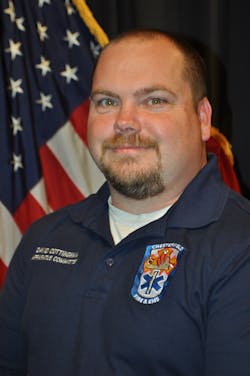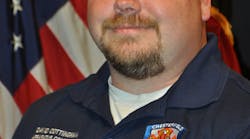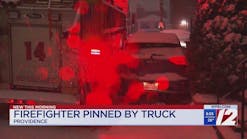David Cottingham, EVT of the Year, Talks About the Job
Source Firehouse.com News
David Cottingham Jr., the 2014 Emergency Vehicle Technician of the Year, is shop supervisor for the Chesterfield County, Va., Heavy Vehicle Maintenance Shop and oversees all apparatus maintenance for Chesterfield Fire and EMS, one of the five largest departments in the State of Virginia. Chesterfield is a combination department of almost 500 personnel located southwest of Richmond.
Cottingham worked for the Virginia Department of Transportation for seven years before moving to Chesterfield County and working on emergency apparatus. "Everybody likes to work on fire trucks and I found a home," he said.
Cottingham and a staff of 10, including six EVTs, maintain a fleet of 21 front-line engines, 11 reserve engines, five ladder/platforms with All Steer technology, two straight ladder/platforms, three heavy rescues, three tenders, 18 front-line ambulances, 11 reserve ambulances, 10 brush trucks, 12 battalion chief SUVs, a command vehicle, a mass casualty unit, numerous boats, approximately 40 staff vehicles and several trailers for technical rescue, hazardous materials, special operations and deployment of specialty teams.
After spending several years as one of the county's top mechanics in the shop and assuming a leadership role, Cottingham was promoted to acting supervisor and subsequently shop supervisor.
In his nomination letter, Chesterfield's Lt. Michael D. Martell, Standing Apparatus Committee Chair, commends Cottingham as a "Consummate professional at all times, treating all internal and external customers with the utmost respect." Martell added that Cottingham has implemented several programs to save costs, reduce out of service time and has even appointed a roving field mechanic to address smaller issues in between normal biannual maintenance cycles.
When he first moved to the county shop nine years ago, the fire department, police department and the maintenance shop were fairly autonomous. Three years ago things started to change when, still a tech, Cottingham was invited to attend a meeting of the Standing Apparatus committee.
"At one of the first I went to I (learned) how things were going from their view and I told them how it was going from our view," he said. "That's how it started and it just blossomed. Now I attend all of their apparatus meetings, whether we're talking about old pieces of equipment or buying new ones. It's sort of like 'cradle to grave.' I see it from the time it gets here to the time it leaves."
He added, "We've moved forward to where we are now. Those guys have been just as good to me as I am for them."
Cottingham has a master’s certification in trucks and continues to pursue and promote EVT certifications among his shop technicians. He works hard to stay current on NFPA regulations, CAAS (Commission on Accreditation Ambulance Services) regulations and KKK ambulance standards. In addition, he is focused on good relationships between dealers and his staff to expedite repairs, warranty service and parts delivery.
"Apparatus has changed a lot going from a hard-wired system to a multiplex system. We're seeing now module-control in lights, less wires in vehicles and a lot more computer-controlled items on trucks," he added. "The emission stuff has been a big thing for all of us and getting through the hurdles with that."
In addition, Chesterfield's ambulances see heavy use according to Cottingham. "We've got ambulances that are a couple years old and have 100,000 miles on them. Some of them run non-stop."
Contagious diseases, particularly in light of the Ebola outbreak have sparked reviews of how the ambulances are cleaned before coming into the shop for maintenance.
"Our medics do a very good job before we get them," said Cottingham. "If the ambulance comes straight from a scene, we know that prior to getting inside. We have protection on before we do anything."
All the Chesterfield EVTs wear P2 gloves when they go in the back for safety.
"In the past six months since Ebola, if they transport a patient that might have been exposed, they'll decon the unit elsewhere before it goes anywhere or to us."
Soft-spoken and humble, Cottingham readily credits his success in the Chesterfield shops to good working relationships with the Chesterfield Fire and EMS Department and encourages other departments to be open to change.
"I think being involved in those apparatus meetings really gave me an understanding that I could bring back to the guys in our shop of what (firefighters and medics) actually do out there," he said. "If I know what they go through on scene or on the road, I can help them more because I know more of what they need out there. It keeps us all focused on the same things. Being involved with all the logistical guys over there that handle the equipment has also helped."
What advice would Cottingham offer someone considering a job in emergency vehicle maintenance?
"My advice to them is that it's a very good field," Cottingham said. He likes to hire young guys and train them. "You can't beat the old guys on the floor--here for 20 years--for what they know and what they have seen come through the shop compared to someone fresh out of a school."
"What we found is the best way to get into the field is to bring in new hires and put them with one of our emergency vehicle technicians and let them train them for six months and then depending on where they are in the field of the vehicles, up to a year to get them out to be a good technician."
Cottingham also encourages certified classes supplied by the dealers and directly related to the equipment they work on."The best thing for anybody is to get as much training as you can," he said.
And focus on diagnostics.
Cottingham stated, "Every time I look at websites there's something new out--different ways to turn the rear wheels on a truck or different ways to maneuver into a scene. It's hard to keep up with, so technicians really need to focus on what's new coming out and a lot of stuff is computer-related on laptops. The main thing is finding people that are good at diagnosing stuff--find a problem and get in there and fix it. Diagnostics is where I think their key focus should be and keeping good equipment on the road so firefighters are safe."
Last words?
"Thanks to everybody in our fire department and Chief Loy Senter for letting us see his operation," said Cottingham. "All the guys I work with are great!"
In its eleventh year, the Emergency Vehicle Technician of the Year Award, was created to raise the awareness of the hard-working, dedicated technicians and mechanics working behind the scenes to keep emergency apparatus and first responders safe across North America. This year, a panel of five judges, including three previous EVT of the Year award winners and representatives from the EVT Certification Commission and the Fire Department Safety Officers Association, reviewed the 26 nominations received.
The award will be presented next week at the the Fire Department Safety Officers Associations' Apparatus Specification and Maintenance Symposium, in Orlando, Fla. and is sponsored by C.E. Niehoff & Co.







